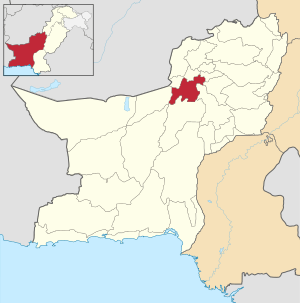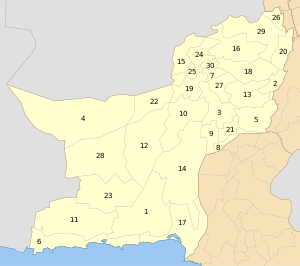Mastung District
Mastung District (Urdu: ضلع مستونگ) is a district located in the northwest of Balochistan province, Pakistan. Prior to its creation as a separate district in 1991, Mastung was part of Kalat District.[1]
Mastung District ضلع مستونگ | |
|---|---|
 Map of Balochistan with Mastung District highlighted | |
| Coordinates: 29°45′N 67°00′E | |
| Country | Pakistan |
| Province | Balochistan |
| Established | 1991 |
| Headquarters | Mastung |
| Area | |
| • Total | 5,896 km2 (2,276 sq mi) |
| Population (2017)[2] | |
| • Total | 266,461 |
| • Density | 45/km2 (120/sq mi) |
| Time zone | UTC+5 (PST) |
Administration
The district consists of three tehsils:[3]
Prior to 2006, within these there were 12 union councils: Khadkocha, Ghulam Parenz, Karez Noth, Mastung-1, Mastung-2, Sorgaz, Dasht, Isplinji, Kanak, Shaikh Wasil, Kardigap and Soro. In 2006, one additional union council formed with the name of Alizai, bringing the total union councils to 13.
On 13 July 2018 a suicide bomber blew himself up during a Politic procession of Baluchistan Awami Party in which over people were killed, including a candidate from PB35 Mastung Nawab Siraj Raisani.
Demography
In 2005 the population of Mastung district was estimated to be over 180,349. The major religion is Islam, which accounts for 99% of the total population.[4] The text of the 1998 census report suggests that the main language in the district is Brahui,[5] but the actual figures of the census (which did not provide a separate option for Brahui) indicate that 80% of the population declared their mother tongue to be Balochi.[6] There is also a sizeable minority of Pashto speakers (6%).[6]
The major tribes of the district are the Bangulzai, Raisani, Tareen, Shahwani, Muhammad Shahi, Sarpara, Kurd, Lango and Dehwar.[5] The other tribes in the area are Abizai, Syeds, Rodeni, Alizai, Mengal, Satakzai, Mashwani, Sumalani, Sarangzai, Lehri, Barozai, Zhar Tareen, Rind, Babri Ghilji/Khilji, Khurasani and Durrani. Mastung District inhabitants are mostly descended from immigrants from present-day Afghanistan and CARs 800–900 years ago except few Brohi tribes like Bangulzai and Shahwani etc. Dehwar tribe is a mixture of many small clans like Khawaja Khel, Alizai, Durrani and Aabezai. Babri is another biggest clan that migrated from Ghazni Afghanistan in the 12th century (basically belongs to Khilji Pashtoons), now settled in Babri village in Kanak Valley. Babri clan is one of the oldest sub-tribe of Mastung with healthy figures. The Babris also own a huge land starting from Sheikhwasil, Sheerin Aab, Dirin Garh and extends up to Sayyed Aleem.
Education
According to the Pakistan District Education Rankings 2017, district Mastung is ranked at number 74 out of the 141 ranked districts in Pakistan on the education score index. This index considers learning, gender parity and retention in the district.
Literacy rate for 2014–15 of population 10 years and older in the district stands at 59% whereas for females it is only 38%.[7]
Post primary access is a major issue in the district with 79% schools being at primary level. Compare this with high schools which constitute only 8% of government schools in the district. This is also reflected in the enrolment figures for 2016–17 with 15,842 students enrolled in class 1 to 5 and only 642 students enrolled in class 9 and 10.
Gender disparity is another issue in the district. Only 36% schools in the district are girls’ schools. Access to education for girls is a major issue in the district and is also reflected in the low literacy rates for females.
Moreover, the schools in the district lack basic facilities. According to Alif Ailaan district education rankings 2017, the district is ranked at number 107 out of the 155 districts of Pakistan for primary school infrastructure. At the middle school level, it is ranked at number 115 out of the 155 districts. These rankings take into account the basic facilities available in schools including drinking water, working toilet, availability of electricity, existence of a boundary wall and general building condition. 4 out of 5 schools do not have electricity in them. More than half the schools lack a toilet and 1 out 3 schools do not have a boundary wall. 3 out of 5 schools do not have clean drinking water.
The main issues reported in Taleem Do! App for the district is the poor condition of schools. Schools are reported to be missing infrastructure and authorities are neglecting these schools. Unavailability of teachers in another major issue reported in Taleem Do! App.
Notable people
- Liaqat Ali Bangulzai, senator
See also
- 2017 Mastung suicide bombing
- Mastung Valley
- Babri Tribe
References
- PCO 2000, p. 1.
- "DISTRICT WISE CENSUS RESULTS CENSUS 2017" (PDF). www.pbscensus.gov.pk. Archived from the original (PDF) on 2017-08-29.
- Tehsils & Unions in the District of Mastung - Government of Pakistan Archived 2012-02-09 at the Wayback Machine
- PCO 2000, p. 16.
- PCO 2000, p. 7.
- PCO 2000, p. 18.
- Pakistan Bureau of Statistics (2016). Pakistan Social and Living Standards Measurement Survey 2014-15. [online] Islamabad: Government of Pakistan, p.111. Available at: http://www.pbs.gov.pk/sites/default/files//pslm/publications/PSLM_2014-15_National-Provincial-District_report.pdf [Accessed 6 Aug. 2018].
Bibliography
- 1998 District census report of Mastung. Census publication. 99. Islamabad: Population Census Organization, Statistics Division, Government of Pakistan. 2000.
External links
| Wikimedia Commons has media related to Mastung District. |
